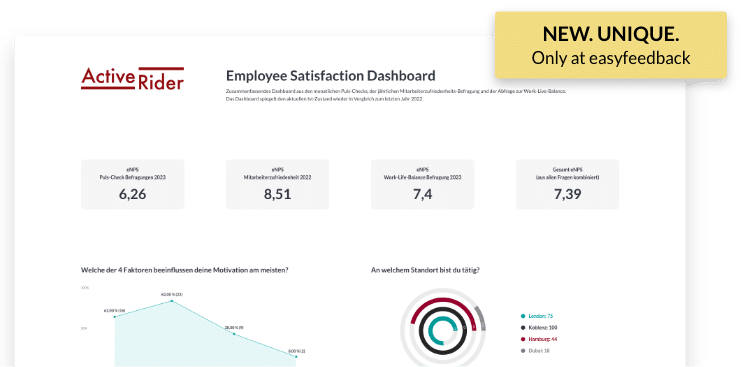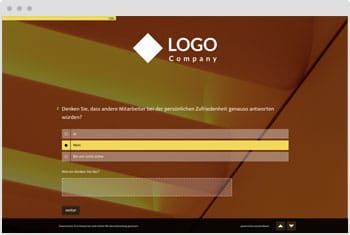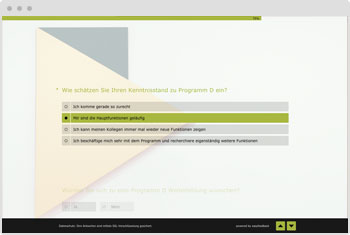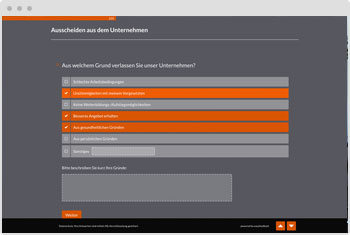Uncover and improve weaknesses in your internal communication through surveys

With this ready-to-use survey template, you can find out if there are any places where your company's internal communication can be improved.

“Identifying customer needs is an essential part of our business. easyfeedback accompanies us for many years as a loyal partner in this task. We particularly appreciate the intuitive usability of the survey tool as well as the professional support.”
Guild Lead User Experience Research

“We use easyfeedback for internal and external surveys – fast, comfortable and really easy! Straightforward and cordial support can always create a smile. We really appreciate the permanent development of the platform.”
Guest & Competitor Insights Analyst
Content and targets of this internal communication survey template
Is internal communication targeted and efficient? Are all recipients consistently involved in the flow of information? Internal communication can be a decisive factor for the success of a company.
Give your employees all the information they need and at the same time the appreciation of being involved. Use employee surveys to find out if you can improve internal communication. Your employees know best what they are lacking. Just ask them!
Content:
• Query on departmental affiliation
• Information flow from management & supervisors to employees
• Review formal communication channels
• Identify informal communication in hallway conversations
Targets:
• Improve internal communication by identifying weaknesses
• Strengthening team spirit
• Integration of employees in decision-making processes
• Constructive communication instead of rumor mongering
• Efficient flow of information

Data privacy protection „made in Germany“ (GDPR)

Anonymity functions for open feedback
Almost everything you need to know about internal communication
1. What is internal communication?
Internal communication is an instrument that regulates all communication and information relationships in the company by means of clearly defined media or media used as required.
As a subarea of overall corporate communication, it includes communication between management and employees as well as between employees themselves.
A distinction is made between formal internal communication and informal internal communication.
Formal internal communication involves the targeted dissemination of information to all those involved, for example via minutes or exchanges within a planned meeting.
Informal communication involves the mostly unstructured dissemination of information to the person encountered, for example at a chance meeting at the copier or in the cafeteria.
2. Why is internal communication important? What influence does it have within the company?
Communication is the magic ingredient for any functioning relationship. If there is a balance between speaking and listening and if communication is appreciative, this has a positive effect on the relationship. However, if the communication is rather one-sided or if people hardly talk to each other, problems quickly arise in the relationship.
This is no different for communication within a company. If something is not right in the communication, this can become a problem for the company, which can affect all company divisions and all employees. This makes it all the more important to deal with this aspect.
For example, suppose an employee is constantly missing necessary information to perform his or her duties. This could lead to him being unable to perform the assigned tasks or to the quality of his work suffering as a result. This would have a negative impact on both the employee’s mood and the company’s ability to achieve its goals.
On the other hand, good internal company communication can also contribute to an increase in the company’s effectiveness. Appreciative interaction has a positive effect on the motivation of employees, who become more loyal to the company and work more productively.
Internal communication thus has a major influence on the achievement of corporate goals and on corporate culture. It increases the feeling of togetherness and promotes open communication and transparency within the company.
3. What are the pillars of internal communication?
The pillars of internal communication include the communication strategy, the communication culture and the communication structure.
Communication strategy refers to both the conceptual and strategic planning of internal communication. This is about defining what information members of the organization need to work well.
Communication culture is about how to communicate with each other. What kind of interaction is necessary both for the achievement of goals and for appreciative cooperation? This usually involves defining a corporate philosophy, a mission statement for cooperation among employees, and a management strategy.
The communication structure deals with the processes and structures to be able to communicate well. In terms of communication transfer, a distinction is made between centralized structures with a few short and therefore fast communication paths and decentralized ones with several longer communication paths.
4. What are instruments of internal company communication?
In addition to digital communication options, such as e-mails, the intranet, or even messenger services like Skype or Slack, face-to-face conversations are also an important – if not the most important – instrument of internal corporate communication that management and staff can use to communicate with each other.
For successful corporate communication, it is particularly important to use the available tools correctly. For each topic or project, the individual suitability of the instruments should therefore be checked in advance.
For example, a short e-mail to a supervisor or colleague is probably sufficient for a brief query about a topic that has already been discussed, whereas a face-to-face meeting attended by everyone involved is probably the more suitable option for project planning for a new order.
5. How to improve internal communication in the company?
The importance of internal communication is constantly growing due to the intensity and fast-moving nature of tasks and objectives. Below we have compiled some tips on how you can optimize the internal communication channels in your company:
1. Determine the current state
Find out what kind of communication is practiced in your company. What is already going well and where do your employees think there is still room for improvement?
Employee surveys are a good way to determine the current state. You can easily create a questionnaire for internal communication using our survey tool or you can directly use our sample template for internal communication.
2. Choose the right instruments
Choose the right tools for each communication topic. If the topic concerns one or more employees, then choose the face-to-face conversation or the team meeting, depending on the issue. If it is only a supplement to a topic that has already been explained, then a short e-mail or chat message will probably suffice instead of a face-to-face meeting.
3. Communicate in a targeted manner
Only communicate information to employees for whom this information is relevant. Otherwise, there is a risk that important information will not reach the appropriate place or will be lost in the flood of information.
4. Communication is a dialog
Make sure that your communication works in both directions. Pure top-down communication is not conducive to employee satisfaction. Listen actively to your employees and take their expressed problems or suggestions seriously.
5. Communicate transparently and honestly
Always communicate openly and honestly with your employees. Especially when things are not going so well. In this way, you prevent rumors, uncertainties and resentment and create a basis of trust.
6. What questions can I ask in a survey to improve internal communication?
The goal of the questionnaire on internal communication is first to determine the current state. What is already going well and where is there still potential for improvement. Based on the answers given, you can derive possible measures for improvement and thus actively contribute to the optimization of your internal communication.
We have put together some questions for you below:
- Do you receive all the information you need for your work?
- How do you rate the communication within your team?
- What do you think could be improved in the communication within your team?
- How does the communication with your supervisor work?
- What tools do you use most often for internal communication?
- Do you find the tool you use suitable for internal communication?
You can find more possible questions in our internal communication questionnaire template.
You are in professional company







easyfeedback welcomes more than 740.000 participants per month!







